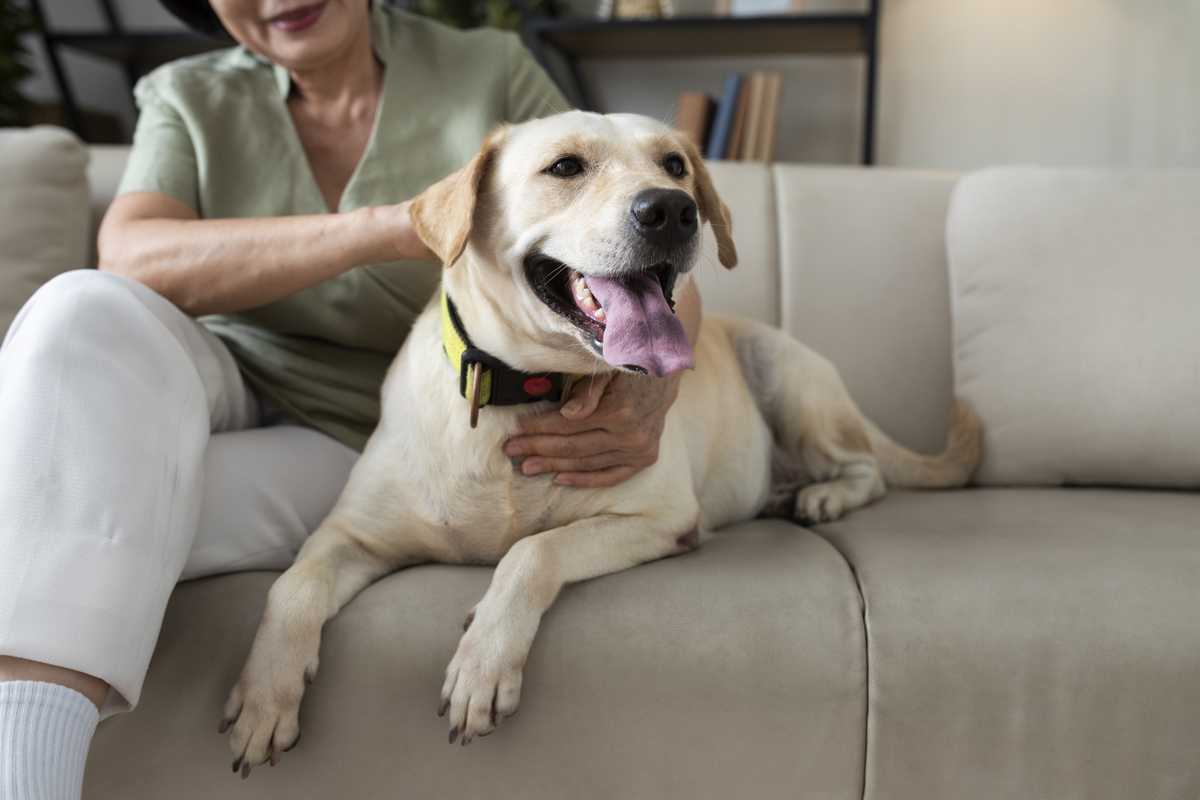- Psychiatric Service Dogs - What Are They?
- What Does Training a Psychiatric Service Dog Include?
- All types of service dogs, including Psychiatric Service Dogs, always go through:
- Psychiatric Service Dogs and Companion Animals - Are There Differences?
- Psychiatric Service Dog Tasks
- Who Can Train a Psychiatric Service Dog?

The idea that the public has of service animals has gradually changed over the years. If the nature of service dogs was initially associated with guide and mobility assistive tasks only, it is now paired with a variety of tasks, that refer not only to the physical but also to the mental health of a person. Speaking of mental health, the important role of psychiatric service dogs in improving the emotional state and the general well-being of their owners has become more noticeable than ever.
There are still some misconceptions that surround these animals, which are mostly caused by confusing them with emotional support animals. Nevertheless, psychiatric service dogs have earned their reputation as reliable and essential support animals, who can perform many different tasks to help individuals deal with mental illnesses.
What tasks can Psychiatric Service Dogs be trained to perform is one of the main questions that we will answer in today’s article.
Psychiatric Service Dogs - What Are They?
Psychiatric Service Dogs can be dogs only (certain US states also accept miniature horses as service animals), who have been individually trained to perform specific tasks for the benefit of a person with a mental disability such as depression, PTSD, anxiety, bipolar disorder, schizophrenia, disruptive behaviors, dissocial disorders...etc.
What Does Training a Psychiatric Service Dog Include?
All types of service dogs, including Psychiatric Service Dogs, always go through:
2. Specialized service dog training;
3. Public access manners.
Basic obedience commands like “sit”, “stay”, “come”, and “down”, as well as calmly walking on a leash is absolutely mandatory for all dogs who are on the way to becoming service animals. Training always begins with the fundamentals, so a dog can learn to behave appropriately and be a polite family and society member.
Gradually training becomes more advanced and specific tasks, that are directly related to a disability must be taught. Although there are some tasks, considered essential for Psychiatric Service Dogs (we will list these a bit later in the article), these can vary depending on the person’s symptoms and needs.
By “public access manners” it is meant that a dog knows how to behave in public places, where there are a lot of distractions such as people, animals, smells, sounds, etc. All of these distractions can be overwhelming for a not properly-trained service dog. That is why it is essential for service dogs to be able to ignore the distractions in their surroundings and not let these prevent them from performing their tasks.
Psychiatric Service Dogs and Companion Animals - Are There Differences?
Yes, there are several important differences between both types of animals. While companion animals like Emotional Support Animals can be not only dogs but all kinds of domesticated species, including cats, rabbits, guinea pigs...etc. Psychiatric Service Dogs, on the other hand, are limited to dogs only (as mentioned above, some US states also recognize miniature horses are service animals).
A second essential difference between both types of animals is that service dogs do specific work-the tasks they perform are directly related to a disability. Companion animals do not go through specialized service dog training but through basic obedience training only. They provide companionship and comfort thanks to their presence, but they do not do specific work directly related to a disability.
The difference in how these animals work and their training directly correlates to their access rights. Service dogs are allowed access to public places, as they are deemed medical equipment. Companion animals can be denied access to public places, especially if they run a “no-pets” policy.
An important clarification we need to make is that Emotional Support Animals in the US are protected under the Fair Housing Act, which perceives them as equal to Service Animals when it comes to housing rights.
Since we have already clarified some important aspects of the nature of Psychiatric Service Dogs, let's move to the next point, namely what tasks these dogs can perform.
Psychiatric Service Dog Tasks
As the name suggests, the tasks these dogs perform are meant to mitigate the symptoms of mental disabilities. One of the most essential PSD tasks is:
Deep Pressure Therapy
Generally, there are two methods for Deep Pressure Therapy to be performed by a Psychiatric Service Dog:
• The “Lap” task;
• The “Chin” task.
Dogs of smaller breeds typically perform the lap version of the task, as their weight allows them to jump into their owner’s laps or onto their legs and use their body warmth and weight to provide a calming effect.
The chin version of the task is usually performed by larger dog breeds, that are too heavy to lie down in their owners’ laps. In order to provide a calming effect to their owners, larger dogs put their chin on the owner’s legs or arms instead.
Tactile Stimulation
Tactile stimulation comes in various forms including giving a kiss, nose-nudging and pawing at the owner. It can be used for different purposes such as calming the owner down, interrupting repetitive behavior, bringing the owner back to reality if they are having an episode/flashback...etc.
What type of tactile stimulation a Psychiatric Service Dog will be trained to provide, depends on the individual. Some people feel more comfortable having their dogs paw at them, while others prefer their canines to give them a kiss. There are owners who do not like getting licked on the face but prefer their canines to lick them on the arms instead... It all varies from person to person.
Alerting to Anxiety
Alerting the owner to an oncoming anxiety episode is another essential task that Psychiatric Service Dogs can be taught to perform.
There are two main techniques used in training a dog to alert to anxiety episodes:
• Association with anxiety;
• Responding to tells.
Association with anxiety means teaching a dog to perceive anxiety episodes as something outside the standard behavior and encouraging them to show a specific behavior as a response. The easiest way to do this is to immediately call your paw friend once you feel you are about to have an anxiety episode or a panic attack and give them a reward (usually in the form of their favorite treats).
Some dogs are not food-driven, so if this is the case, you may want to consider praising, petting, and giving toys as a suitable alternative to food. The main idea of this is to teach your dog to recognize the episodes as a cue and respond to them. Knowing that he/she will be very well rewarded for showing the wanted behavior, your paw friend will feel motivated to continue exhibiting it.
Responding to tells, on the other hand, means teaching a dog to recognize a specific behavior, that the owner shows prior to having an episode. This behavior can be something only you and your family/close friends know about, i.e. you scratch your skin or rub your legs prior to experiencing an episode.
Once you start showing that behavior, you should ask your dog to fulfill a specific already-learned command, such as “Give a kiss”. Over time, you can start waiting for a few seconds prior to giving your dog the vocal command. Over time, you should fade out the vocal commands until the only cue is the specific behavior you show prior to having an episode.
Retrieving Items
Although retrieve tasks may not look like something that Psychiatric Service Dogs are specialized in, they count as one of the essential tasks these dogs can perform.
People who deal with anxiety, PTSD, bipolar disorder, depression, and other types of mental disabilities can find themselves in situations when they are unable to reach their medication, phone, or other items needed. This could be caused by an occurring episode, a side effect of medication, or other disability-related symptoms that impede the normal functioning of a person.
Retrieve tasks can be life-saving to people with different types of disabilities and also be helpful in both cases- when an individual is about to have an episode and after an episode has already occurred. In the first case, retrieving tasks can contribute to preventing the episode from occurring, while in the second case, they can help a person recover from an episode more quickly.
Guiding the Owner to a Safe Place / Finding an Exit
This is another important task that Psychiatric Service Dogs can be trained to perform. It can be extremely helpful while being in public and having an anxiety episode or a panic attack. At the moment your paw friend steps outside, you need to say a cue word like “exit” or another one based on your preferences. Then, you should immediately reward your dog. It is important that you do not use cue words that your canine already associates with their regular walks or playtime outdoors.
The chosen word should be utilized only in the training sessions. You need to practice this several times and once your paw friend goes out without hesitation, you may want to change the location-practice in a different room or switch the front and the back door (i.e. if you live in a house).
The second step is to incorporate the anxiety episodes into the training sessions. Once your dog understands the concept, you should start making up an episode or the behavior that accompanies your episodes. Then you should give your dog the command he/she already knows- “exit” or the one you have chosen.
Practice from different locations, and change the distance from your canine. Gradually you can add some distractions so he/she can learn to focus on the task regardless of the surroundings.
Crowd Control
This task is more specific and is usually suitable for people whose disorders make them extremely proximity sensitive. Dogs can be trained to circle around their owners or get into a “stand” and/or “sit” position to prevent passersby from getting too close to the owner.
It is essential that your dog is able to remain calm and friendly towards strangers and does not become overly protective of you. During the training sessions, you may need to ask your friends for help. Let a friend approach you from different directions. Once they come close to you, give your dog a command to get into a wanted position.
Practice with different people, and different locations and ask them to approach you from different directions. Always mark the wanted behavior and reward your dog when he/she fulfills the given command.
Environmental Tasks
“Environmental tasks” is a generalized term, used to describe specific actions related to the surroundings of a person with a disability. These can include opening/closing doors, and cabinets, turning lights off/on, pulling down the curtains (helpful to people with light sensitivity), and bringing certain items to the owner (similar to retrieving tasks). In general, a person with a physical or psychiatric disability can train their dog to take a specific action that involves their surroundings.
Reminding to Take Medication
Instead of thinking about whether you set your alarm to ring when you need to take medication or not, you can teach your paw friend to remind you instead. Of course, we need to clarify that dogs are living beings, they still can make mistakes and under certain circumstances, they may be unable to perform the learned tasks, i.e. if they are sick or develop some issues due to changes in their environment. Your service dog does not replace medical exams and medication, so you should keep this in mind.
However, if you take your medication at certain times during the day, you can set an alarm with a specific ringtone, that will be used for training purposes only. Once the alarm stops ringing, you need to call your paw friend, take your medication, and reward them. Over time your canine will start pairing the ringtone with treats. After several repetitions, you need to start hiding the treats, i.e. put them in your pocket.
The idea is for your dog to become more persistent in their activities in order to get the treats. Your paw friend is likely to try to get your attention to receive the treats. You can teach your canine to show a specific behavior like nose-nudging, pawing, or giving a kiss (or whatever works for you), in order to be rewarded. After a few repetitions, your canine will start showing the learned behavior at certain times of the day (when the alarm used to ring) to get a reward. Over time, he/she will learn to notify you even without the alarm being present.
The tasks listed above are several of the most essential tasks that Psychiatric Service Dogs can be trained to perform. However, they vary from person to person, so you can train your paw friend to exhibit the behavior that actually works for you.
Who Can Train a Psychiatric Service Dog?
Depending on where you are based, you may be allowed to engage in psychiatric service dog training yourself. Some countries like the US, the UK, and the Netherlands allow dog owners to train their pet dogs as service dogs themselves. Other countries recognize as service animals only dogs who have been professionally trained and certified by members of ADI or IGDF.
There are also countries where the laws vary on a regional/provincial level, e.g. Canada. Some provinces allow owners to conduct self-training, while others require dogs to be trained by ADI members or to go through an additional process of evaluation if they have not been trained by an accredited school.
If you consider the opportunity to benefit from a Psychiatric Service Dog, you should get familiar with the local laws first and what your training options are.













